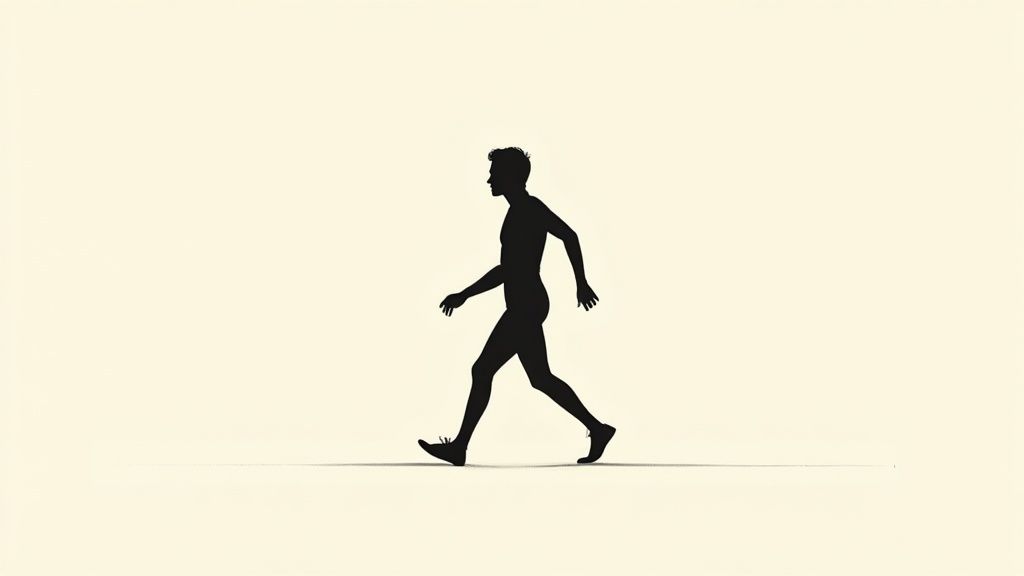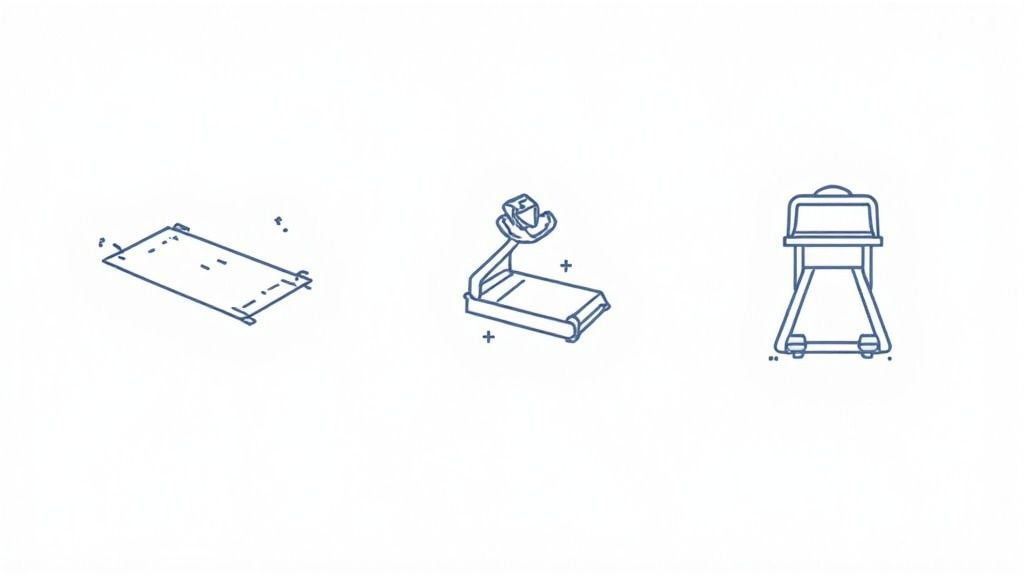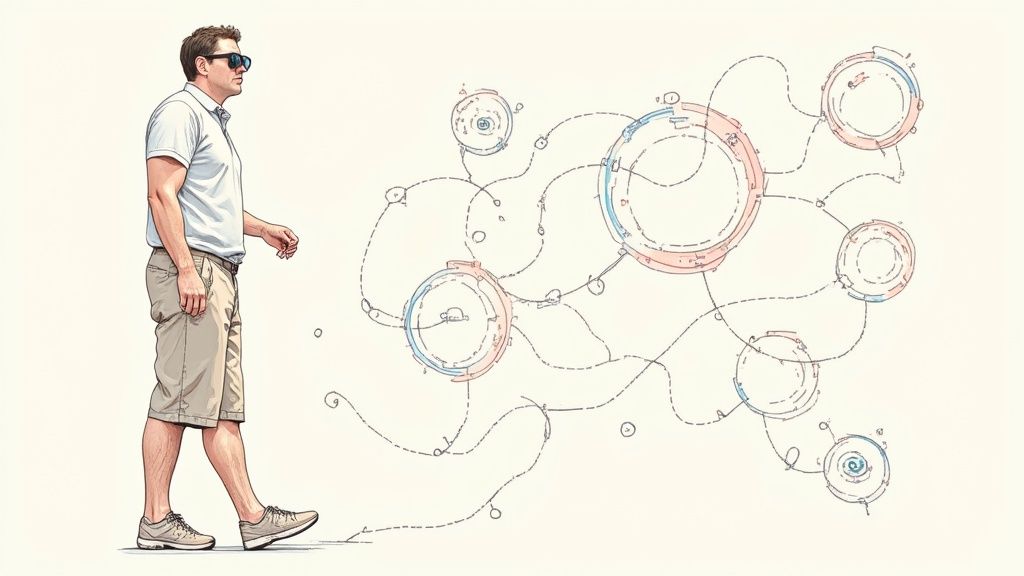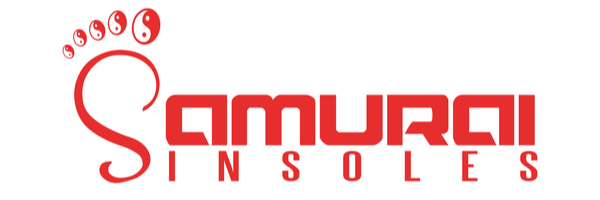Ever wonder how you walk? It seems simple, but the way you move is a complex, personal signature—almost like a fingerprint. Gait analysis is just a fancy term for studying that signature, a deep dive into how you walk or run.
Think of it as a movement detective story. Experts look for tiny clues, imbalances, or awkward patterns in your stride that could be the secret culprits behind pain or potential injuries. It’s a go-to tool for athletes trying to gain an edge, but it's also incredibly valuable for anyone looking to solve chronic foot problems for good.

Decoding Your Walk: More Than Just Steps
You take thousands of steps a day without a second thought. But behind this automatic motion is an intricate dance of muscles, bones, and joints. Even a slight hiccup in how your foot lands or your ankle rolls can create a chain reaction, sending stress all the way up to your knees, hips, and lower back.
So, when we talk about what gait analysis is, we're really talking about understanding the story your body tells with every step. It’s about how you absorb impact, stay balanced, and push off the ground to move forward.
Why Your Unique Walk Matters
An inefficient or "abnormal" gait isn't always something you'd notice. You might have been walking a certain way your whole life, completely unaware that it's the real reason for that nagging heel pain or the ankle that always seems to ache after a long day. The whole point of a gait analysis is to bring these hidden habits into the light.
By taking a close look at your stride, a professional can spot the mechanical quirks that often lead to common issues like plantar fasciitis, Achilles tendonitis, and especially overpronation.
This approach gets to the root of the problem. It’s the difference between just putting ice on a sore foot and figuring out why your foot got sore to begin with.
To give you a quick snapshot, here’s a simple breakdown of what a gait analysis looks at.
Gait Analysis at a Glance
| Aspect | Description |
|---|---|
| Gait Cycle | The complete motion from when one heel strikes the ground to when the same heel strikes again. |
| Phases of Gait | Breaking down the cycle into smaller parts, like the stance phase (foot on ground) and swing phase (foot in air). |
| Foot Mechanics | Observing how the foot rolls inward (pronation) or outward (supination) upon landing. |
| Joint Angles | Measuring the movement and alignment of the ankles, knees, and hips throughout the stride. |
| Symmetry | Comparing the left side of the body to the right to spot any imbalances or compensations. |
This table shows how a detailed analysis moves beyond a simple glance to provide actionable insights.
From Observation to a Real Solution
A professional gait analysis can be as straightforward as a trained eye watching you walk or as advanced as using high-tech treadmills with pressure sensors and slow-motion video. No matter the method, the goal is the same: to create a clear picture of your movement and flag any trouble spots.
This information is then used to build a personalized plan to get you moving better. This often involves:
- Customized Orthotics: Using insoles, like Samurai Insoles, that are specifically designed to support your arch and correct issues like overpronation.
- Physical Therapy: Prescribing exercises to strengthen weak muscles and improve flexibility where you need it most.
- Form Adjustments: Offering simple coaching cues to tweak your stride for less impact and better efficiency.
At the end of the day, analyzing your gait is the first real step toward moving without pain, lowering your risk of injury, and finally finding lasting relief.
The Two Phases of Your Gait Cycle

Every single step you take is part of a complex, repeating rhythm called the gait cycle. Think of it as one complete stride—from the moment your heel strikes the ground all the way until that same heel hits the ground again.
It might feel like one smooth, continuous motion, but it’s actually a beautifully coordinated event made up of two main parts: the stance phase and the swing phase. Each part gives us clues about how your body handles stability, generates power, and moves efficiently.
Grasping these two phases is the first step in any real gait analysis. For the average adult, this entire cycle takes about 1 to 1.2 seconds, though things like your age and how fast you're moving can change the timing. If you're curious about the technical side, you can explore more on the professional methods used in in-depth gait training principles.
The Stance Phase: Your Foundation of Movement
The stance phase is exactly what it sounds like: it’s the entire time your foot is in contact with the ground. This is the workhorse of your stride, handling everything from absorbing the shock of impact to propelling you forward. When you're walking, this phase accounts for about 60% of the whole cycle.
Let's break down what happens when your foot is on the ground:
- Initial Contact (Heel Strike): The cycle kicks off the instant your heel makes contact with the ground. This is a critical moment for shock absorption.
- Loading Response (Foot Flat): Your foot then rolls forward until it's flat on the surface. This is where we can really see issues like overpronation, which is when the foot rolls too far inward.
- Mid-Stance: For a brief moment, your body weight is perfectly balanced directly over your foot. This is your point of maximum stability.
- Terminal Stance (Heel Off): Your heel begins to lift, and your weight shifts onto the ball of your foot, getting ready to push off.
- Pre-Swing (Toe-Off): The grand finale of the stance phase. Your big toe pushes off the ground, launching you forward into the next step.
In this short sequence, your foot has to transform from a flexible shock absorber into a rigid, powerful lever. It’s pretty amazing.
The Swing Phase: Effortless Momentum
As soon as your toe leaves the ground, the swing phase begins. This phase makes up the other 40% of the gait cycle and ends just before your foot lands again. Its main job is to swing your leg forward so it’s in the right position for the next step.
While the stance phase is all about brute force—handling your body weight and pushing off—the swing phase is more about finesse. It requires precise muscle control to lift your foot clear of the ground and guide its path forward smoothly.
This phase also has its own mini-steps, from the initial lift-off to swinging past your other leg, and finally, preparing to land. A slight hitch or inefficiency here can easily throw off your entire rhythm and compromise your balance.
By looking at both the stance and swing phases, we can start to connect the dots and see how seemingly small issues in your gait can ripple out and cause bigger problems.
How Professionals Perform a Gait Analysis

So, how do the experts turn something as simple as walking into a detailed report on your body's mechanics? A professional gait analysis isn't a one-size-fits-all process. It can be as straightforward as a trained eye watching you walk, or as advanced as a full-blown lab assessment with sophisticated gear.
Each approach peels back another layer of the onion, revealing more about your unique movement signature.
The most common starting point is a visual gait analysis. You’ve probably seen this if you’ve ever been to a specialty running store. Someone will ask you to walk or jog on a treadmill while they watch, looking for obvious signs like how much your foot rolls inward (pronation) or the way your foot strikes the ground.
It’s a great first step, but this method only scratches the surface. To really understand what’s happening, professionals need technology that can see what the naked eye misses in those split-second movements.
The High-Tech Toolkit for Gait Analysis
Modern gait analysis has come a long way from just watching someone walk. Today’s technology allows clinicians and specialists to measure forces, angles, and timing with incredible precision. This gives them objective, hard data instead of just an educated guess.
Here are some of the key tools you’ll find in a professional’s arsenal:
- Slow-Motion Video Analysis: High-speed cameras capture your stride, allowing an expert to review it frame by frame. This is where they can spot subtle issues—a slight drop in your pelvis or a heel that lifts a fraction of a second too late—that are completely invisible in real time.
- Pressure-Sensing Platforms: Imagine a mat or treadmill covered in thousands of tiny sensors. As you walk or run over it, the platform creates a dynamic, color-coded map of your foot. This map shows exactly where you're putting the most and least pressure throughout every single step.
- 3D Motion Capture: This is the gold standard of movement analysis. Small, reflective markers are placed on key joints like your hips, knees, and ankles. A system of infrared cameras then tracks these markers in three-dimensional space, creating a digital "skeleton" that shows precise joint angles and limb movements.
When experts use these tools, they’re applying core principles of biomechanics to deconstruct your movement. This same deep understanding of forces and motion is used across all kinds of physical activities. For example, grasping the details of pro-level biomechanics can be the difference-maker in an athlete's performance.
From Data Points to a Clear Diagnosis
The whole point of using this tech isn't just to gather a bunch of numbers and charts. It’s to connect the dots between the data and your actual experience, whether that’s nagging pain or just feeling inefficient.
A pressure map might show a hot spot of force on the outside of your foot, immediately explaining your chronic ankle soreness. Similarly, 3D motion capture could reveal that one hip drops lower than the other with every step, pinpointing the true root cause of what you thought was just a "bad knee."
By combining these technologies, a professional gets a complete picture of your kinetic chain—the interconnected system of joints, muscles, and nerves that work together to create movement.
This comprehensive view leads to a highly accurate diagnosis. Instead of guessing, the expert can identify the specific mechanical flaw causing your issue. From there, they can create an effective plan, which often includes targeted exercises, adjustments to your form, and supportive gear. Understanding your own gait is the crucial first step when you choose the right insoles to help correct any imbalances.
Connecting Your Gait to Foot Pain and Overpronation

That nagging ache in your arch? That sharp, stabbing pain in your heel first thing in the morning? It's almost never a random occurrence. More often than not, it’s a direct result of how you walk.
Think of your gait as the foundation of a house. If that foundation is even slightly off, it’s only a matter of time before cracks start showing up in the walls upstairs. Your body is no different. A subtle flaw in your walking pattern sends a ripple of stress up your entire kinetic chain—impacting your ankles, knees, hips, and even your lower back.
This is exactly why a gait analysis is so important. It lets you look past the immediate pain to find the real, underlying cause. Instead of just treating the symptoms with temporary fixes, you get to the bottom of the mechanical issue that started it all.
The Problem of Overpronation
One of the most common issues a gait analysis uncovers is overpronation. Now, a little bit of inward roll after your heel hits the ground is perfectly normal and healthy; it’s how your foot absorbs shock. The trouble starts when your foot and ankle roll too far inward and downward. That's overpronation.
This excessive motion causes the arch of your foot to flatten out, putting a massive amount of strain on all the surrounding soft tissues. Your muscles, tendons, and ligaments have to work overtime just to keep you stable.
Imagine your foot's arch is like the suspension on a car. With overpronation, that suspension is bottoming out on every single step, sending a jolt through the entire frame.
It's this constant, repetitive strain that is a primary driver behind so many chronic foot conditions.
Linking Gait Imbalances to Common Conditions
An unbalanced gait isn't just awkward—it’s an active contributor to real, painful problems. The link between how you walk and where it hurts is surprisingly direct. Here’s how it often plays out:
- Plantar Fasciitis: Overpronation creates a constant tug-of-war on the plantar fascia, that thick band of tissue on the bottom of your foot. This leads to inflammation and the signature heel pain that defines the condition.
- Achilles Tendonitis: When your foot collapses inward, your lower leg twists internally. This unnatural motion puts a grinding stress on your Achilles tendon, causing irritation and pain.
- Shin Splints: The muscles on the front of your shin get exhausted trying to control the excessive foot motion. Eventually, they become overworked and inflamed, resulting in shin splints.
- Bunions: An unstable foot caused by overpronation can lead to your big toe drifting inward, which is how a painful bunion often forms at the base of the toe.
By pinpointing these mechanical flaws, a gait analysis gives you a clear roadmap to feeling better. Instead of guessing what might work, you can target the problem with supportive footwear or specific exercises. Many people find incredible relief by using orthotic insoles for pronation, which are specifically designed to support the arch and guide the foot back into a healthier alignment, tackling the pain at its source.
Turning Your Gait Analysis Into Action With Insoles
A gait analysis gives you a ton of information, but data is only useful when you do something with it. Once you know exactly how your body moves, the next step is to turn those findings into a real solution. Think of your gait analysis report as a personalized roadmap to correcting your unique biomechanical issues.
Specific details, like discovering you overpronate or that you put too much pressure on the ball of your foot, point directly to the kind of support you need. It’s a bit like getting a prescription; the diagnosis (your gait pattern) tells you exactly what kind of remedy (the insole design) will work best. This is how you bridge the gap between knowing what's wrong and actually fixing it.
For instance, if your analysis shows your arch collapses with every step you take, you know that a simple, squishy drug-store cushion won't cut it. You need an insole with firm, structured arch support to stop that collapse and guide your foot back into a healthier alignment.
Matching Gait Problems to Insole Solutions
A good insole isn't just a piece of foam; it's an engineered tool designed to correct the exact problems your gait analysis found. Samurai Insoles, for example, are built with a springy inner core that delivers serious support without feeling like you have a brick in your shoe. This kind of targeted design gets right to the root cause of pain.
The real job of an insole isn’t just to add cushion—it's to control and correct motion. By stabilizing the foot, a quality insole stops the chain reaction of stress that travels up to your knees, hips, and even your back.
Let's break down how specific gait issues can be matched with the right insole features.
Here’s a simple table to show how the issues uncovered in a gait analysis line up with specific features in a well-designed insole.
| Gait Problem Identified | Corresponding Insole Feature | How It Helps |
|---|---|---|
| Overpronation | Structured Arch Support | Prevents the arch from collapsing, reducing strain on the plantar fascia and Achilles tendon. |
| Heel Instability | Deep, Stabilizing Heel Cup | Cradles the heel to control side-to-side motion, improving overall stability during the foot strike. |
| Uneven Pressure | Full-Length Orthotic Shape | Distributes body weight more evenly across the entire foot, relieving pressure on hot spots. |
| Poor Shock Absorption | Cushioned Top Layer | Provides comfort and absorbs impact forces, which is especially helpful for hard surfaces. |
This shows how the right insole works as a mechanical fix for your foot’s specific needs. You can explore how different types of arch support orthotic insoles are built to solve these common biomechanical problems.
By using the insights from your gait analysis, you can finally move beyond just managing pain and start proactively correcting the underlying flaws causing it. Once you have the right support, you’ll feel the difference in everything you do. You might even find yourself enjoying activities you’d given up on, and you can rediscover the health benefits of walking during golf without the nagging foot pain. This is how you turn abstract data into real-world comfort and freedom.
Your Top Questions About Gait Analysis, Answered
Alright, even after breaking down the science, you probably still have some practical questions about what to expect. That's completely normal. Let's walk through some of the most common things people ask so you can feel totally prepared.
How Long Does a Gait Analysis Take?
This really depends on where you go and what you need.
If you pop into a specialty running store for a footwear recommendation, you’re likely looking at a quick 15-20 minute process. They'll probably have you jog on a treadmill for a bit while they watch.
On the other hand, a full clinical workup with a podiatrist or physical therapist is a much deeper dive. When they bring out advanced tools like pressure-mapping sensors or 3D motion capture cameras, the appointment could last anywhere from one to several hours. They're collecting a ton of data to get to the root of a specific issue.
Do I Need a Referral from a Doctor?
For a basic analysis at a footwear store, you can just walk right in—no referral needed.
However, if you're seeking a clinical gait analysis to diagnose a medical problem causing you pain, your insurance might require a referral from your doctor. The best bet is to simply call the podiatrist's or physical therapist's office beforehand to check on their policy.
Key Takeaway: A simple analysis for new shoes is easy and accessible. A diagnostic analysis for a medical issue is a more formal healthcare appointment.
Can Gait Analysis Really Help with My Knee or Back Pain?
Absolutely. It’s one of the most common reasons people get one! Your body is a connected system, often called the kinetic chain. Think of it like a series of dominoes.
When your foot mechanics are off—let’s say from overpronation—that first domino tips over. It forces your ankle and shin to rotate inward, which in turn twists your knee and throws your hip out of alignment. Before you know it, you're dealing with nagging pain in your knees, hips, or even your lower back, all stemming from an issue that started in your feet.
By identifying and correcting the problem at its source—your gait—you can often relieve pain all the way up your body. It’s about fixing the foundation, not just patching up the cracks.
If your gait analysis points to overpronation as the culprit behind your pain, the right insoles are an incredibly effective solution. Samurai Insoles are specifically designed to correct these biomechanical imbalances, giving you the support and stability needed to move comfortably and confidently. Find your perfect pair today.



